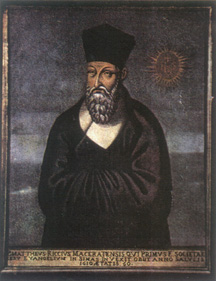 Fr. Matteo Ricci, S. J.. Renewer of Geographic studies, studious of Chinese language and first preacher of the Gospel in China.
Fr. Matteo Ricci, S. J.. Renewer of Geographic studies, studious of Chinese language and first preacher of the Gospel in China.
1. The first great Cultural encounter between China and Europe involved a two-hundred-year experience that began in the last decades of the sixteenth century and came to a faltering end in the last years of the eighteenth century. The crucial intermediaries in this encounter were missionaries, primarily of the Society of Jesus. One of the pioneering figures was the Jesuit Fr. Matteo Ricci (Li Madou) who formulated the framework of cultural accommodation between Chinese and European Cultures. One of the last figures was the Jesuit Fr. Giuseppe Castiglione (Lang Shining) who served as a Court painter to the Qianlong Emperor. Of the Jesuits alone, nearly five-hundred of the brightest and most energetic Europeans of that time served in China. 1
The China mission exerted a powerful attraction on Europeans of the seventeenth and eighteenth centuries, not only among men of God but also among intellectuals. China was among the most absorbing topics of that time and works on China written by missionaries were so carefully studied that an amateur group of European students of China developed whom I refer to as "proto-Sinologists." Drawing upon missionary sources in the form of published works, annual reports, unpublished manuscripts, correspondence and personal contacts with returned missionaries, these proto-Sinologists began to integrate China into the primary intellectual concerns of Europeans. Although there were amateur distortions and ungrounded enthusiasms, the fact is that the assimilation of one culture by another does not take place in an intellectual vacuum. The proto-Sinologists were laying the groundwork for the more professional Sinology that would begin in the nineteenth century.
The Chinese participants in this first great Cultural encounter were mainly literati who tended to fall into three categories in their responses to the Jesuits' overtures: (1) hostility, (2) curiosity and (3) sympathy. While a majority of literati were hostile, the degree of hostility was shaped by internal political and Cultural changes in China during this time. These changes increased literati hostility toward the Jesuits during the latter part of this two-hundred-year Cultural encounter. The Chinese were more receptive to the Jesuits' message during the early period of this encounter, in part, because the late Ming cultural atmosphere was relatively accommodating and inclined toward blending different religious teachings into a harmonious whole.
The Manchu conquest of 1644 altered this atmosphere by fostering orthodoxy at the expense of experimentation. In practical matters, the Manchu Emperors were quite willing to utilize the considerable skills of the foreign missionaries. However, in terms of the Cultural atmosphere, the ruling Manchus embraced the most orthodox Confucian philosophy available, that of the Neo-Confucian Zhu Xi (°1130-†1200), in order to lessen their foreign stigma. The Manchus greatly restricted freedom of thought and sponsored several literary inquisitions.
Experimenting with new or unusual ideas became dangerous for Chinese literati because it could lead to controversy that might attract the interference of the Manchu rulers who were very sensitive to criticism. Moreover, many literati became disillusioned with late Ming experimentation in blending different teachings on the grounds that this had degenerated into empty talk and dangerous heterodoxies which contributed to the downfall of the Ming Dynasty. Nevertheless, the process of inculturation of Christianity into Chinese Culture continued into the early years of the eighteenth century. Meanwhile, the Chinese Rites Controversy debate emanating out of Europe began to undermine the Jesuits' accommodative framework as a basis for cultural encounter and, in addition, alienated the Chinese Emperors' support for the missionaries. Finally, by the late eighteenth century, European enthusiasm for things Chinese began to run its course and gave way to a critical reaction.
2. The causes of Chinese hostility to the first great encounter between Chinese and European Cultures have been explained in terms of the imperviousness of Chinese Culture to foreign influences. This Chinese imperviousness has often been interpreted as a Cultural trait or prejudice and explained as an irrational xenophobia or hatred of all things foreign. However, Chinese dislike of foreign things was based upon more than irrationality.
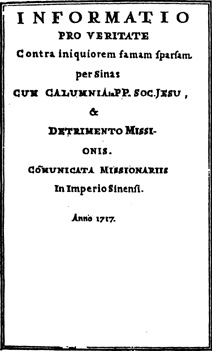 Frontespiece.
In: Ed. STUMPF, K., Informatio Pro Veritate Contra iniquiorem famam sparsam per Sinas Cum Calumnia in PP. Soc. Jesu, & Detrimento Missi[|]onis. Comunicata Missionariis in Imperio Sinensi, Beijing, [n. n.], 1717, title page.
An important document pertaining to the history of the Rites Controversy.
It contains a translation of the anti-Christian memorial made by Chen Ang to the Kangxi Emperor.
Frontespiece.
In: Ed. STUMPF, K., Informatio Pro Veritate Contra iniquiorem famam sparsam per Sinas Cum Calumnia in PP. Soc. Jesu, & Detrimento Missi[|]onis. Comunicata Missionariis in Imperio Sinensi, Beijing, [n. n.], 1717, title page.
An important document pertaining to the history of the Rites Controversy.
It contains a translation of the anti-Christian memorial made by Chen Ang to the Kangxi Emperor.
The teaching of the missionaries was attacked by many literati as heterodox and variously called yi duan, xie and zuo dao, each of which carries a sense being of "different from the way of the sages".2 However, there was an additional aspect to the Chinese view of heterodoxy that we are inclined to overlook. The weakening concensus on absolute truths found in Western societies today has led many to interpret heterodoxy as merely 'different'. Because seventeenth and eighteenth century Chinese literati had greater confidence in the veracity of their teaching, they interpreted heterodoxy to mean 'false' and referred to their own teaching by the name of zheng jiao (literally, 'orthodoxy'), but orthodoxy in the sense of Truth. A heterodox teaching was not merely different; it was false.
The French Sinologist Jacques Gernet has argued, in a widely-read book, that the Chinese negative reaction to Christianity was not mere xenophobia but rather was a result of the unique character of the Chinese language. This language shaped the Chinese method of reasoning and favoured certain orientations of thought which were incompatible with European Christian modes of reasoning.
Whereas the Indo-European structure of language with the important verb to be has produced a sharp distinction between 'being' and 'becoming', the Chinese language lacked a word to denote 'being' or 'essence'. Gernet argues that the inflections of Indo-European languages produced sharp differences between nouns and adjectives and established a fundamental opposition between essential and secondary qualities (ie: essence and accident) in the Aristotelian-Scholastic sense. This has produced in the history of Western thought a notion of realities which are transcendent and immutable in part because they achieve an independence from sense impressions. It was this notion of permanent and ideal reality that was said to be at the core of Christianity. By contrast, the lack of inflections and other distinctive features of their language is said to have led the Chinese to view realities as more dependent upon sense impressions and, hence, more transitory. The different orientation in thought among the Chinese made it very difficult for them to assimilate the scholastic patterns of thought which the seventeenth and eighteenth century missionaries took from Europe to China. According to Gernet, this different orientation in thought was the primary cause of China's rejection of Christianity.
Another recent explanation that rejects xenophobia as the primary reason for China's rejection of Christianity during the seventeenth and eighteenth centuries is offered in a book by the Hong Kong historian John Dragon Young. 4 Unlike many scholars who have argued that Confucius and his Confucian followers were indifferent to religion, Young sees the causes of the Chinese rejection of Christianity to lie in the literati 's deep attachment to Neo-Confucianism as a religion. In fact, Neo-Confucianism acted as a rival point of view to Christianity. He argues that Neo-Confucian morality has a religious and cosmological basis but lacks the notion of a God as an omnipotent and personal deity. This idea of God was, according to Young, alien to the Confucians who believed in the unity of Heaven, Earth and Man. The literati rejected Christianity, not because of an emotional attachment to Neo-Confucianism, but because Christianity was philosophically incompatible with Neo-Confucianism.
Young believes that the famous Jesuit missionary Matteo Ricci perceived this intellectual incompatibility and, because of this, was vehement in his attack on Neo-Confucian metaphysics in his Tianzhu shiyi (The True Meaning of God) (1603). In short, Christianity and Neo-Confucianism contained opposing world-views in which the major point of conflict involved the idea of God. According to this view, it was neither the Rites Controversy nor the foreign origins of Christianity which caused its failure in China. Rather, it was its ethical and metaphysical incompatibility and the "moral absoluteness of the Confucian tradition, supported by a Neo-Confucian metaphysical base" that was the cause of the failure of the first encounter between China and Europe. 5 Only a fatal compromise on both sides could have prevented this failure from happening. Unlike the Christian critics of Jesuit methods in China, Young sees the failure of the encounter as constituting clear evidence that Ricci and the other Jesuits did not compromise their Faith.
3. The Chinese Rites Controversy was a debate engendered by conflicting approaches to conducting a mission in foreign lands. Viewed from the point of view of two extremes, the Jesuit tendency to be accommodating, flexible and tolerant of indigenous Cultures was regarded as flawed by most members of the mendicant Orders (Franciscans, Dominicans and Augustinians) as well as by secular Orders, such as the Société des Missions Étrangères, of Paris. It was regarded as flawed because it compromised the Truths of Christianity. Exactly where the Universal essence of Christianity stops and the Cultural manifestation of Christianity begins is a topic that continues to be debated today, for example, in the ongoing struggle between the Vatican and Chinese State over who has the authority to consecrate Bishops.
Whereas most (but not all) Jesuits tended to tolerate certain Chinese ancestral rites, the mendicants disallowed them; whereas the Jesuits tended to tolerate rites to Confucius as essentially secular, the mendicants disallowed them on the grounds that they represented a form of idolatry; whereas most Jesuits inclined to accept the ancient and indigenous Chinese terminology (Shangdi and Tian) for God, the mendicants disallowed these terms on the grounds that they were irretrievably tainted by superstitious beliefs and they insisted instead that new Chinese terms, such as Tianzhu, be used because they more accurately reflect the uniqueness of the Christian God. Even if one regards the mendicants as wrong on these Rites Controversy issues, they were neither foolish nor insincere and the debate is a complicated one. Several of these complexities have been presented [by J. S. Cummins] from a Dominican perspective in a recent study of one of the most famous and vituperative critics of the Jesuits, the Dominican friar Domingo Navarrete. 6 In the crucial struggle among these opposing viewpoints for the Pope's support, the mendicants won. In the ruling in 1715 and then again in 1742, the Vatican ruled in such a way that the Jesuit approach of accommodation was discredited.
The Rites Controversy spilled over into the political sphere of relations between Beijing and Rome where it initiated a struggle that continues today. Rome regarded the Kangxi Emperor's pronouncements on the Chinese Rites to be an interference by a civil authority in a strictly religious matter whereas Kangxi regarded the rulings of Rome to be a foreign intrusion into an internal domestic matter. (The insistence of Beijing on certain matters being internal domestic affairs is still heard today. If the context of the insistence today is very different from the seventeenth and eighteenth centuries, the pattern itself is very old in dealings between China and the outside World). Rites Controversy bickering contributed to Kangxi's disillusionment with Christianity, although he continued to support individual Jesuits at Court. In Europe, ultimately, anti-Jesuit forces associated with the Rites Controversy led to the dissolution of the Society of Jesus by the Vatican, in 1773. By the time the order was reconstituted, in 1814, the Jesuit missionaries were never again to regain their lost momentum in China.
The reasons for the collapse of the first great Cultural encounter between China and Europe are not reducible to one basic cause. Only those who believe in conspiracy explanations of important World events can indulge themselves in reducing complex historical events to the conspiracy of a few scheming individuals. Nevertheless, a conspiracy theory has been proposed for the Chinese Rites Controversy.
In 1956, Malcolm Hay published a book in which he traced the origins of the failure of the Jesuits in China to a plot instigated by an obscure Scotsman named William Leslie, who from 1659 to 1707, served as archivist of the Sacred Congregation of the Propaganda Fide, in Rome. 7 Hay maintains that Fr. Leslie worked with other Jansenists of the Société des Missions Étrangères in providing them with secret documents from the Propaganda Archives to undermine the Jesuits' work in China. This may have been true and this archivist of the Propaganda may have been part of a consipracy. However, while a conspiracy may explain a specific event, such as a political assassination, it does not suffice to explain a complex and extended struggle. The failure of Jesuit accommodation in China is too complicated to be explained in terms of a plot instigated by an archivist in the Propaganda.
4. In 1644, when the Manchus conquered China, the Chinese Cultural atmosphere was changed into something far less open and receptive to foreign ideas. There were, however, two groups of Christians in China who continued to think, write and act with the aim of reconciling Chinese Confucian and European Christian Cultures. One group was the Figurists who are known, but not seriously studied. The other group consisted of Chinese literati in Eastern China, who are not well-known and have only just begun to be seriously studied.
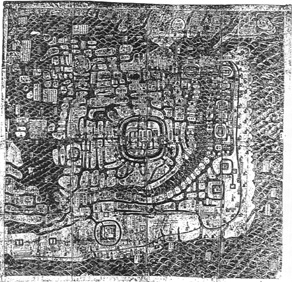 Mappa Christianitatis Duarum Orbium In Provincia Nankinensi Ubi Supra 100 Ecclesiae Numerantur & Supra 60 Millie Christianorum.
Particularized manuscript of the Prefecture of Songjiang, in the Province of Jiangsu, showing the location of one-hundred Churches (tianzhutang, or Lord of Heaven's Hall) serving sixty-thousand Christians. Made with the aim to inculcate the strength of evangelization in that region.
Mappa Christianitatis Duarum Orbium In Provincia Nankinensi Ubi Supra 100 Ecclesiae Numerantur & Supra 60 Millie Christianorum.
Particularized manuscript of the Prefecture of Songjiang, in the Province of Jiangsu, showing the location of one-hundred Churches (tianzhutang, or Lord of Heaven's Hall) serving sixty-thousand Christians. Made with the aim to inculcate the strength of evangelization in that region.
The Figurists consisted of predominantly French Jesuits who argued that if the Chinese Classics were interpreted figuratively rather than literally, one could read them as anticipating the mysteries of Christian revelation. These claims were radical not only because they contradicted the Biblical chronology of the unfolding of Christian Revelation but also because they contradicted the traditional Chinese view that their Classics were works of history that should be read as literal accounts of the past rather than allegorical anticipations of the future.
The leading Figurist was Fr. Joachim Bouvet, S. J. (Bai Jin)(°1656-†1730) who had extensive personal contact with the Kangxi Emperor in the course of several decades of residence at the Beijing Court. Bouvet was encouraged by the Emperor to continue research on his Figurist theories and was even released from Court duties to do so. 8 A second important Figurist was Fr. Joseph de Prémare, S. J. (Ma Ruose) (°1666-†1736) who worked primarily in the Southern Province of Jiangxi rather than in Beijing. 9 Like Bouvet, Prémare assiduously studied old Chinese texts for many years. However, whereas Bouvet's theory or reconciliation was built entirely upon the contents of ancient Chinese texts, Prémare attempted to reconcile Christianity with a broader range of Chinese texts, from the ancient Classics down to those of Neo-Confucianism.
Bouvet and Prémare both toiled for over thirty years on their projects and produced several manuscripts, but because of the prohibitions which Rome had placed on further debate of Rites Controversy issues, these works were forced to remain unpublished for many years. Several of Prémare's works were eventually published in the nineteenth century but Bouvet's works have remained in manuscript form down to the present day. 10 Since these Figurist works were not widely circulated and since discussion of their contents had been prohibited by Rome, there was no opportunity for them to foster further reconciliation between Confucianism and Christianity. It is simply a case of what might have been.
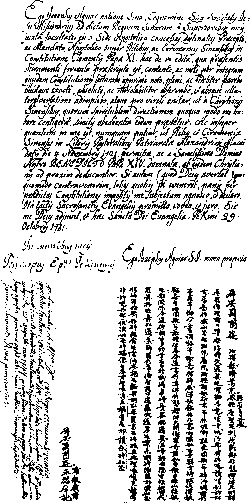 Swearing formula used by the missionaries in the Orient to express their loyalty to Rome.
Manuscript dated the 29th of October 1751. Althought they disagreed with the Papal Bules-- Ex Illa Die, from March 1715, and Ex Quo Singulari, from July 1742 -- about three-hundred missionaries signed "in manibus meis", in front of the Beijing or Macao bishops, documents agreeing to respect the Papal edicts.
Swearing formula used by the missionaries in the Orient to express their loyalty to Rome.
Manuscript dated the 29th of October 1751. Althought they disagreed with the Papal Bules-- Ex Illa Die, from March 1715, and Ex Quo Singulari, from July 1742 -- about three-hundred missionaries signed "in manibus meis", in front of the Beijing or Macao bishops, documents agreeing to respect the Papal edicts.
The second group that continued in the seventeenth and early eighteenth centuries to work on reconciling Confucianism and Christianity were Chinese literati located, for the most part, in eastern China in the provinces of Fujian, Zhejiang, Jiangsu and Shandong. Those who were particularly active in this reconciliation included Zhu Zongyuan (°1609) of Ningbo, Han Lin (ca ° 1600- ca †1644) of Jiangzhou in Shanxi Province, Wu Li (° 1632-†1718) of Changshu in Jiangsu province, Zhang Xingyao (°1633-†1715) of Hangzhou and Shang Huqing (Shiji) of Ji'nan. 11
Some of these literati assisted missionaries in composing works on the reconciliation of Confucianism and Christianity, such as, Shang Huqing who assisted the Franciscan friar A. Caballero a Santa Maria (Li Andang). Other literati worked more independently of Europeans, such as, Zhang Xingyao who collaborated with other Christian literati in writing works of reconciliation and who had numerous disciples in the vigorous seventeenth-century Christian community at Hangzhou. The "Three Pillars of the Christian Church in China" (Xu Guangqi, Li Zhizao and Yang Tingyun) and their attempts to reconcile Confucianism and Christianity have been much studied. However, study of these later generations of literati sympathetic to Christianity has been so neglected that it is widely, though incorrectly, believed that there were no comparable literati successors to the "Three Pillars."
5. Shallow intellectual foundations contributed to the failure of the first great Cultural encounter between Europe and China. A great deal of European interest in China was based upon subjective enthusiasms rather than upon objective intellectual interest. Over the course of the two-hundred-year encounter, one impression of China rapidly gave way to another because these impressions were grounded more upon passing European cultural needs than upon what actually existed in China.
The English scholar R. Dawson chose to express this phenomenon with the image of the lizard which is capable of changing its skin, as in the title of his book The Chinese Chameleon. 12 In his analysis of European conceptions of Chinese Civilization, from Mongol times down to the twentieth century, Dawson classifies the most prominent European images of China. Those images, that apply to the seventeenth and eighteenth centuries, include a picture of enormous wealth perceived by European travellers to China since the time of Marco Polo. Another image viewed the admirable qualities of Chinese Culture, society and government as a worthy model for imitation by Europeans - an image prominent in Jesuit writings. Part of this image included what Mr. Dawson refers to as the myth of the homogeneous Confucian state in which China is administered by literati comparable to rational philosopher-Kings. Seventeenth and eighteenth-century Europeans also saw China in the image of a timeless and unchanging Civilization that contrasted with the increasing tempo of change in European life.
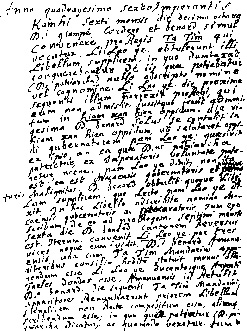
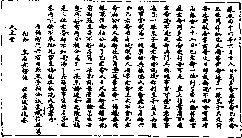
A document related to the visit of Cardinal Charles Thomas Maillard de Tournon, to China.
Excerpt of a petition to the Government of Guangzhou, by Wang Liangbin (Lourenço), concerning the military forces stationed in Macao (KX 46:6:18).
Another prominent European image of China emphasized the uniqueness of Chinese Civilization as something different from European Civilization. It is this notion that has been immortalized in Rudyard Kipling's phrase "East is East and West is West." In the eighteenth century many Europeans conceived of China in an essentially aesthetic dimension as part of the explosion of sentiment for China-inspired Rococo trends. Although the Rococo style was partially derived from China, it was distinctly European and no equivalent was to be found in China. On the whole, the contribution of Dawson's book has been to summarize these European conceptions and distortions of China.
6. There is a deficiency in Dawson's book and one that I formerly shared. The deficiency resides in the belief that the first great Cultural encounter between China and Europe consisted primarily of subjective distortions. The distortions existed and formed an undeniable part of the encounter, but there was also a deeper aspect to the encounter that became apparent to me in the course of doing the research that led to the book Curious Land. 13
What made the China mission unique is that, in China, the Jesuits encountered a Civilization that was so sophisticated and advanced that it challenged European conceptions on a broad range of subject matter. For example, when the Jesuits began to understand the traditional Chinese chronology and to convey this chronology to Europe in the seventeenth century, it became apparent that the greater antiquity of China challenged the shorter chronology then used in Europe to explain Old Testament events in the Bible. This challenge produced a great deal of thoughtful consideration in Europe and the adoption by some of the Greek Septuagint version of the Bible with its more flexible chronology over the less adaptable Latin Vulgate version. One could argue that this change shared with the subjective distortions of China a preoccupation with European knowledge, but this change also involved the objective consideration of outside information to alter European thinking in a very fundamental way. Clearly, the way in which knowledge of China's history caused seventeenth-century Europeans to change the parameters of their own history involved something more than a variation on the "Chinese chameleon" image.
I might briefly mention a book that makes a kind of "Chinese chameleon" argument, but in regard to the Western study of the Middle East. Edward Said's Orientalism14 interprets the European study of the Middle East as a form of European Cultural hegemony. I do not believe Said's theory would apply to the pre-1800 European study of China, though it may apply to the period post-1800. Pre-1800 Sinophilia may not always have been well-grounded in the factual existence of China, but Sinophilia taken apart from missionary motives, seems to represent Europeans seeking not to dominate, but rather to seek something better than existed in Europe. Related to this European search for something better in China was the vast seventeenth and eighteenth-century European travel literature and the related development of the relatively new field of geography. This is another intellectual sphere where the "Chinese chameleon" image does not suffice to explain what was happening. The expansion of European geographical and cartographical knowledge of China brought to seventeenth-century Europeans by Jesuits such as Matteo Ricci, Michele Ruggieri (Lo Mingjian), Martino Martini (Wei Kuangguo), Michael Boym (Bu Mige), Álvaro Semedo (Zeng Dezhao) and Philippe Couplet (Bo Yingli), had an objective content that cannot be reduced to subjective factors. Other areas that transcended the "Chinese chameleon" image were found in the great interest of the new academies of learning in seventeenth and eighteenth-century Europe, such as, the Académie des Sciences of Paris, the Royal Society of London and the Akademie der Wissenschaften of Berlin. The interest of these Societies, in China, sprang from some of the most profound intellectual motives of that Age.
7. The degree to which the atmosphere in Sino-European Cultural relations changed after 1800 is revealed in the experience of the Anglo-Chinese College, at Malacca, on the Malaysian peninsula. The Anglo-Chinese College was founded by the English missionary Robert Morrison (°1782-†1834) who arrived in Macao in 1807. Morrison, often called the first Protestant missionary to China, was a product of the eighteenth and nineteenth century Evangelical movement in England whose missionary zeal led to the founding of missionary Societies, such as the London Missionary Society, in 1795. The latter sponsored Morrison with the aim of producing a new Chinese translation of the Bible. However, Morrison never penetrated China proper (except to accompany Lord Amherst, to Beijing, in 1817) but remained in Guangzhou for twenty-five years. The contrast here with the Jesuits of two-hundred years earlier is striking. Whereas the Jesuits had also arrived in Macao and moved on to Guangzhou, they had soon penetrated the Chinese mainland and, by 1601, were residing in Beijing. The Protestant missionaries are often said to have failed to establish Christianity in China because of their rigidly Eurocentric and Imperialist views. While this was probably true of most Protestant missionaries, Morrison did not fit that stereotype. On the contrary, he adopted many of the same approaches that the Jesuits had used. 15
Morrison believed that it was necessary for a missionary to study the Chinese language and Culture in a manner that would foster the reciprocal cultivation of Chinese and European literature. While Europeans studied the Chinese language and literature, Chinese should study European languages and literature. This would lead eventually, Morrison believed, to the conversion of Chinese to Christianity. And yet there was something very different about Morrison's missionary effort from that attempted by the Jesuits two-hundred years before, though whether the differences lay in Morrison's approach or the different cultural atmosphere of the early nineteenth century or the different political conditions is not clear.
It was with the aim of promoting reciprocal study of Chinese and European Cultures that Morrison founded the Anglo-Chinese College in 1818. He thought it preferable to establish this essentially secular, liberal arts Institution, in Malacca, among Overseas Chinese, rather than in China proper because conditions were not yet ripe, in China, for the College. When James Legge was sent out to East Asia by the London Missionary Society, in 1840, he recommended that the Anglo-Chinese College be moved to China. Though the College at Malacca was closed in 1843, it was never reestablished in its original form.
The closing of the Anglo-Chinese College raises all sorts of questions. Was this an essentially human failure in the sense that Morrison and his Protestant colleagues were less capable than their Jesuit predecessors? Or was the failure due to a less substantial kind of accommodation than the Jesuits had established? Had the intervening years and socio-economic changes in Europe made these Protestant missionaries incapable of approaching China without a sense of superiority? Had the Rites Controversy so poisoned the atmosphere in China against Christianity, that China in the early nineteenth century was less conducive to accepting Christianity than when the Jesuits arrived two centuries before? Whatever the answers to these questions are, it is clear that by 1800 the first great Cultural encounter between China and Europe had ended.
CHINESE GLOSSARY
Bo Jin 白晉
Bo Yingli 柏應理
Bu Mige 卜彌格
Chen Shouyi 陳受頤
David [D. E.] Mungello 孟德衛
Fang Hao 方豪
Fang Hao liushi zi ding gao 方豪六十自定稿
Guoxue ji kan 國學季刊
Han Lin 韓霖
Kai jiao san da zhushi 開敎三大柱石
Lang Shining 郎世寧
Li Andang 利安當
Li Madou 利瑪竇
Luo Mingjian 羅明堅
Ma Ruose 馬若瑟
Mingmo qingchu yesuhuishi de chuan jiaoguan ji qi fanying 明末淸初耶穌會士的傳敎觀及其反應
shangdi 上帝
Shang Huqing 尚祜卿
Shiji 識已
tian 天
tianzhu 天主
Tianzhu shiyi 天主實義
Wu Li 吳歷
Wei Kuangguo 衛匡國
xie 邪
Yang Tingyun 楊廷鈞
yiduan 異端
Zeng Dezhao 曾德照
Zhang Xingyao 張星曜
zhengjiao 正敎
Zhu Zongyuang 朱宗元
Zhongguo tianzhujiao shi renwuchuan 中國天主敎史人物傳
zuodao 左道
NOTES
1 STANDAERT, Nicolas, S. J., The Jesuit Presence in China: A Statistical Approach, in: "Sino-Western Cultural Relations Journal", Cedar Rapids, (13)1991, pp. 4-17.
2 COHEN, Paul, China and Christianity: the Missionary Movement and the Growth of Chinese Antiforeignism, 1860-1870, Cambridge, Massachusetts, Harvard University Press, 1963, pp. 4-5.
GERNET, Jacques, Chine et Christianisme, action et réaction, Paris, Éditions Gallimard, 1982, pp. 322-333.
4 YOUNG, John Dragon, Confucianism and Christianity, the First Encounter, Hong Kong, Hong Kong University Press, 1983, pp. 27-39, 108,126-128.
5 Ibidem, p. 128.
6 CUMMINS, J. S., A Question of Rites: Friar Domingo Navarrete and the Jesuits in China, Aldershot, Scholar Press, 1993.
7 HAY, Malcolm, Failure in the Far East: Why and How the Breach between the Western World and China First Began, London, Neville Spearman, 1956.
8 COLLANI, Claudia von, P. Joachim Bouvet, sein Leben und sein Werk, Nettetal, Steyler Verlag, 1985.
9 LUNDBAEK, Knud, Joseph de Prémare (1666-1736) S. J.: Chinese Philology and Figurism, Aarhus, Aarhus University Press, 1991--For the most complete account of Fr. Prémare's Figurist views.
10 Comp. PRÉMARE, 1728, Ed. GAUTHIER, G., Lettre sur le monotheisme des Chinois, Paris, G. Gauthier, 1861.
See: MUNGELLO, D. E., The re conciliation of Neo-Confucianism with Christianity in the Writings of Joseph de Prémare, S. J., in: "Philosophy East and West", (26) 1976, pp. 389-410 -- For the discussion of Prémare's Lettre [...]. Prémare's major work of reconciliation was composed in Latin and revised by the author in its final form, in 1725, under the title Selecta quaedam vestigia praecipuorum Christianae Religionis dogmatum ex antiquis Sinarum libris eruta. Trans. BONNETTY, A. - PERNEY, P., Vestiges des principaux dogmas Chrétiens tirés des anciens livres chinois, Paris, Bureau des Annales de Philosophie Chrétienne, 1878 -- For the edition in French of Prémare's Selecta[...].
See: LUNDBAEK, Knud, op. cit., pp. 130-136 -- For the relation of this work to Prémare's Figurist theories.
COLLANI, Claudia von, op. cit. -- For the most complete treatment of Bouvet's works.
Also see: COLLANI, Claudia von, Tianxue benyi -Joachim Bouvets Forschungen zum Monotheismus, in: "China Mission Studies (1500-1800) Bulletin", Cedar Rapids, (10) 1988, pp. 3-33; MUNGELLO, D. E., Unearthing the Manuscripts of Bouvet's Gujin after Nearly Three Centuries, in: "China Mission Studies (1550-1800) Bulletin", (10) 1988, pp. 34-61.
11 FANG Hao, Tianzhujiao shi renwu chuan, 3 vols., Hong Kong, Gongjiao Zhenli Xuehui, 1967-1973 -- For the principal source of biographical information on these Christian literati.
See: FANG Hao, Liushi zi ding gao, 2 vols., Taipei, Taiwan, Xuesheng Shu Zhu, 1969, vol. 2, p. 227-235; CHEN Shou Yi, Mingmo Qingchu Yesuhuishi de Rujiaoguan ji qi fanying, in: "Guoxue Ji Kan", 5 (2) 1935, pp. 31-43 -- For Zhu Zhongyuan.
Also see: CHAVES, Jonathan, Singing of the Source: Nature and God in the Poetry of the Chinese Painter Wu Li, Honolulu, University of Hawaii Press, 1993; MUNGELLO; D. E., The Forgotten Christians of Hangzhou, Honolulu, University of Hawaii Press, 1994 -- For works on the two Christian literati, Wu Li and Zhang Xingyao.
12 DAWSON, R., The Chinese Chameleon: an Analysis of European Conceptions of Chinese Civilization, London, Oxford University Press, 1967.
13 MUNGELLO, D. E., Curious Land: Jesuit Accommodation and the Origins of Sinology, Stuttgart, Steiner Verlag, 1985.
14 SAID, Edward, Orientalism, New York, Pantheon Books, 1978.
15 HARRISON, B., Waiting for China: the Anglo-Chinese College at Malacca, 1818-1843, and Early Nineteenth-Century Missions, Hong Kong, Hong Kong University Press, 1979.
* Ph. D in History (California). Editor of the Sino-Western Cultural Relations Journal. Associate Professor of History and Director of Asian Studies, Baylor University, Waco. Author of Liebniz and Confucianism: The Search for Accord and Curious Land: Jesuit Accomodation and the Origins of Sinology.
start p. 111
end p.